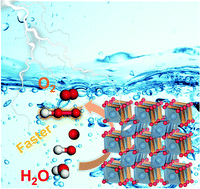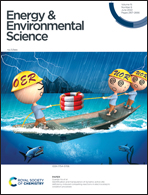Highly active ruthenium sites stabilized by modulating electron-feeding for sustainable acidic oxygen-evolution electrocatalysis†
Abstract
Designing acid-stable oxygen evolution reaction (OER) electrocatalysts with low noble-metal content to facilitate the sluggish kinetics is crucial for sustaining green hydrogen generation. Herein, we developed a rutile-structured ruthenium–manganese solid solution oxide with oxygen vacancies (Mn0.73Ru0.27O2−δ) by using an electron-feeding modulation strategy to stabilize the catalyst structure and accelerate the OER kinetics. Due to the optimal electronic structure and enhanced electrical conductivity, the Mn0.73Ru0.27O2−δ catalyst displayed a low overpotential of 208 mV to reach 10 mA cm−2 current density in 0.5 M H2SO4 electrolyte, outperforming the benchmark RuO2 and most previously reported noble-metal based OER catalysts. Experimental characterization verified that the electron transfer occurred from Ru to Mn atoms with the bridging O atom, which was further enhanced with the existence of oxygen vacancies. Therefore, the center Ru active sites in an electron-deficient state is favorable for bonding with active oxygen intermediates. Meanwhile, theoretical calculations revealed that the simultaneous incorporation of Mn components and O vacancies significantly decreased the anti-bonding spin states of Ru's d-orbitals, which modulated the adsorption and desorption energy barriers of elementary reactions on the active Ru sites, thus boosting the overall OER kinetics.



 Please wait while we load your content...
Please wait while we load your content...